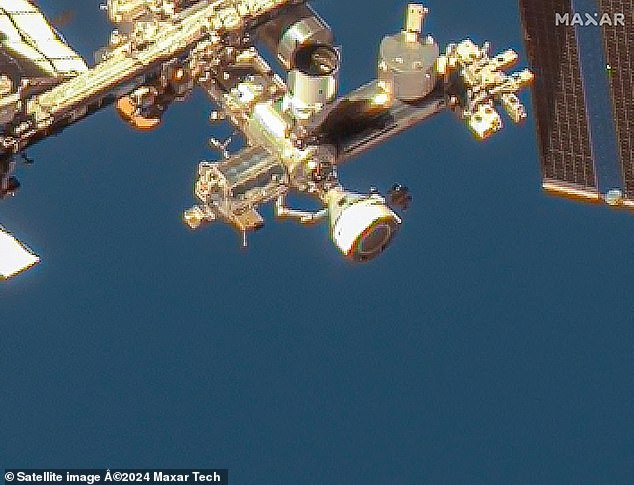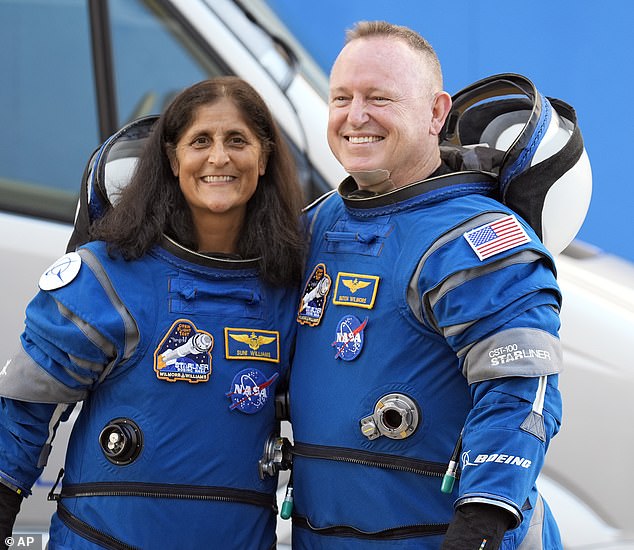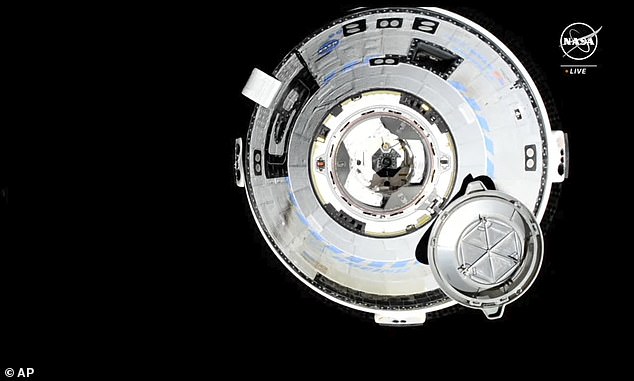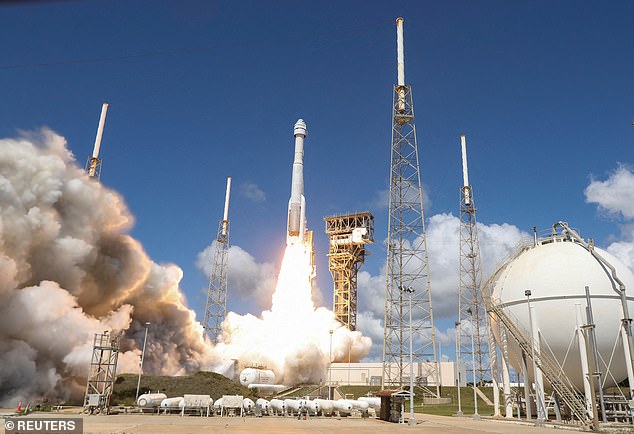How Boeing’s latest scandal could leave NASA astronauts stranded ‘in space’ on the ISS
Boeing’s latest potential scandal is literally out of this world.
The Starliner spacecraft – which carried two NASA astronauts to the International Space Station (ISS) last week – has failed to undock after several faults were found with the ship.
Teams have discovered five different leaks in the spacecraft’s propulsion system, which could prevent the spacecraft from navigating through space as it returns to Earth.
The astronauts were scheduled to return on June 14, but that has been postponed until June 22 while Boeing and NASA work to resolve the issues, leaving the astronauts stranded until then.
Now experts have said NASA could be forced to launch a rescue mission that would be a deeply embarrassing blow to embattled Boeing, which is dealing with a wave of problems plaguing its commercial planes.
The Starliner spacecraft – which carried two NASA astronauts to the International Space Station (ISS) last week – is unable to undock after several faults were found with the ship

Teams discovered five different leaks in the spacecraft’s thrust systems, preventing it from navigating through space as it returns to Earth
A Boeing spokesperson told DailyMail.com: ‘The integrated NASA-Boeing Starliner Mission Management Team oversees the overall health of the spacecraft and adheres to our mission flight rules.
“Even when this smallest helium leak was discovered after docking before the system was closed, we determined that we have approximately 70 hours of free flight activity and that we still have full redundancy in all critical systems.”
DailyMail.com contacted NASA, but the agency declined to comment on whether a possible rescue mission could take place.
Problems with Boeing’s commercial aircraft, including turbulence, mechanical problems and tail strikes, have cost the company at least $3 billion.
And NASA awarded Boeing a $4.2 billion contract to build Starliner as a taxi for astronauts to the ISS.
NASA previously pushed back the return of Butch Wilmore and Suni Williams to June 18, but announced Friday that their stay will be extended again.
“The additional time will allow the team to complete departure planning and operations while keeping the spacecraft clear for emergency crew return scenarios within flight rules,” NASA and Boeing said in a statement.
Boeing’s Starliner can only stay on the ISS for a total of 45 days due to limited fuel in the orbital laboratory – it’s unclear what NASA plans to do if the time is exceeded.
But if the ground teams deem the capsule space worthy, astronauts Butch Wilmore and Suni Williams will board the spacecraft for another 24-hour journey through space and back to Earth.
Starliner was previously scheduled to launch on May 6, but teams discovered a valve leaking helium and scrubbed the mission.
Engineers suspected the problem stemmed from a defective rubber seal the size of a shirt button, and said that even if the leak worsens, it could be fixed during the flight – with the next launch taking place on June 1.
However, Starliner was again plagued by misfortune when the capsule was automatically stopped by a computer shutdown system minutes before takeoff.

Astronauts Butch Wilmore (L) and Suni Williams (R) were scheduled to return on June 14, but that has been postponed until June 22 while Boeing and NASA work to resolve the issues, leaving the astronauts stranded until then

The problems have raised concerns among experts who fear the two astronauts could be stuck on the ISS until a rescue mission is sent
The delay was caused by computers on the Atlas V rocket’s launch pad that coordinate the final moments before liftoff, but the Starliner capsule appeared healthy, officials said.
The problems raised concerns from a NASA contractor who urged the U.S. space agency to “redouble safety checks and reexamine safety protocols to ensure the Starliner is safe before something catastrophic happens.”
Erin Faville, president of ValveTech, expressed concerns about the June 6 launch, telling DailyMail.com: “I warned. I will choose to make it happen.”
Starliner took off from Cape Canaveral Space Force Station in Florida at 10:52 a.m. ET last week with the same leak that required a scrub in May.
Hours after detaching from the Atlas rocket, NASA revealed that the capsule had caused two more spills.
A fourth leak was found after docking on June 6 and the most recent hit on June 10.
In addition to the helium leaks, four thrusters functioned during the flight.
The problems have raised concerns among experts who fear the two astronauts could be stuck on the ISS until a rescue mission is sent.
“Good news is that they are on the ISS and not like Apollo 13 trying to get home from the moon,” Rudy Ridolfi, former space system commander and space technology acquisition manager, told DailyMail.com.
“But I wouldn’t be surprised if someone at NASA is preparing a SpaceX Dragon capsule for a rescue mission.”
Elon Musk’s company has contracted with the space agency to transport astronauts to and from the ISS and has flown ten missions since 2020.
Katsuo Kurabayashi, a professor of aerospace engineering at New York University, said: ‘Given the current situation with the Starliner, it is possible that NASA could decide to use an alternative spacecraft, such as SpaceX’s Crew Dragon, to get the astronauts home safely .

Starliner took off from Cape Canaveral Space Force Station in Florida last week at 10:52 a.m. ET with the same leak that forced a scrub operation in May
“The final decision would depend on the severity of the helium leaks, the feasibility of repairs and the logistics of arranging another spacecraft for the return mission.”
Mike Gruntman, a professor of aerospace at the University of Southern California, also said that “it is more likely that SpaceX will be able to provide an additional launch to retrieve the astronauts in the near future.”
“It is very unfortunate that Boeing’s Starliner is still experiencing problems after so many flight delays,” Gruntman continued.
“For decades, Boeing was one of the most admired aerospace and defense companies. It’s a real national tragedy.’
Although both NASA and Boeing did not appear concerned about the initial leak, Gruntman suggested that the problems stemmed from production issues.
“Multiple similar problems – helium leaks – with apparently similar components, as reported in the press, indicate a systemic problem with design or workmanship or testing or systems engineering or some combination thereof,” he explained.
Ridolfi also noted that the thruster leaks and failures would be “very difficult to repair in space.”
“The last thing you want to do is maintenance in orbit,” he continued.
“Boeing has had ongoing problems with its Starliner, regardless of the delays. We see the same thing, the same components have the same problems.
‘There is no third independent verification and validation (IVV) that carries out follow-up actions on self-inspections.
“This is a cost-saving measure, but without sufficient oversight there will be problems.”
Starliner’s problems follow a slew of problems plaguing Boeing’s commercial aircraft.
A Boeing plane experienced a rare Dutch roll at 32,000 feet mid-flight last month, leading to the aircraft being removed from service.
The Southwest Airlines flight, Southwest Flight 746, was flying 175 passengers from Phoenix to Oakland on May 25 when it experienced the terrifying Dutch roll.
A Dutch roll is the name given to the combination of a yawing motion in which the tail slides and the aircraft rocks from wingtip to wingtip. It is said to mimic the movement of a Dutch skater.
The same month, Singapore Airlines Flight SQ321 experienced fatal ‘turbulence’ associated with proximity to tropical thunderstorms.
The Singapore Airlines Boeing 777 plane left London’s Heathrow Airport at 10:17 pm local time with 211 passengers and 18 crew on board.
However, the turbulence caused several injuries and one death. It is unclear whether the Boeing plane experienced a problem or if it was a natural occurrence.
And last week, an Air Canada Boeing plane burst into flames seconds after takeoff.
